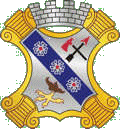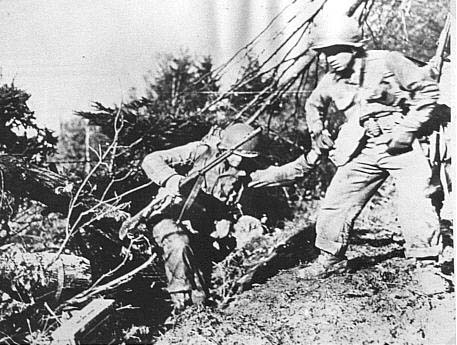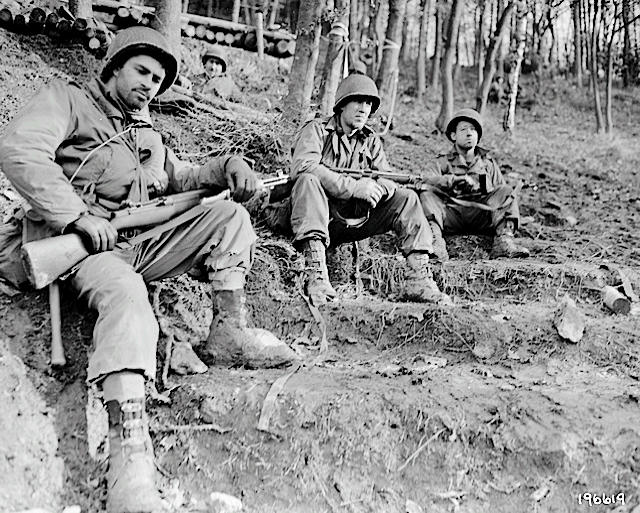(4TH INFANTRY DIVISION) IN THE HURTGEN FOREST,
GERMANY, 16-22 NOVEMBER 1944
(RHINELAND CAMPAIGN)
By Lieutenant Colonel James W. Haley

THE BATTALION ATTACK - 19 NOVEMBER
As the Battalion executive Officer watched the Battalion move through the village of Bend on the morning of 19 November en route to the line of departure, he knew that only superhuman effort on the part of the leaders, especially the Battalion Commander, would be necessary if the Battalion was to be successful. The old men appeared to be still suffering from the effects of the attacks of 16-17 November and the new man appeared to be dejected and low in spirits due to the weather, the mud and the thought of their first taste of action. Only grim fortitude and determination seemed to be pushing the wet, muddy feet of the Battalion. The Executive Officer wondered if this would be sufficient to carry the Battalion through the hard, bloody fighting that lay ahead.

Soldiers of the 8th IR/4th ID on the slopes of the Wehebach valley
on their way towards the Laufenburger Forest.
As the leading element of the Battalion crossed the line of departure at 0800 and started to move up the deep draw running east from the north-south road they came under machine gun fire from Hill 280. This fire was covering a mine field which extended across the draw. (See Map D) Immediately, the leading men took cover and refused to move. The Battalion Commander realized at once that if the attack was to advance every officer would have to lead the way and he began moving toward the head of G Company. Arriving at the mine field he made a hasty reconnaissance and decided to try to by-pass the barrier by moving the Battalion across the draw and then around the base of Hill 280. About this time moderate enemy artillery and mortar fire began falling in the area including some rounds from heavy railroad guns. However, since this fire was not too heavy it was evident that the Germans were throwing most of their artillery against the 3rd Battalion attack. Within thirty minutes G Company was moving again due primarily to the efforts of the Battalion Commander and the Company Commander of G Company and was crossing the draw toward Hill 280. Immediately across the draw and at the base of Hill 280, the company encountered another mine field and several men became casualties. A Company aid man began working his way toward the wounded men but he too stepped on a mine and was seriously injured. Other men voluntarily tried to rescue these casualties from the mine field but not one got further than a few yards before they too were killed or wounded by the Shü mines. About this time, the Battalion Commander reached the area and issued orders that no man was to try to evacuate the casualties from the mine field. To do so was plain suicide.
The Battalion Commander then made a personal reconnaissance of the entire area and by some incredible means escaped the mines. He succeeded in finding a path through the mined area on the south slope of Hill 399 and soon had G Company moving along this path. Enemy machine gun fire continued to sweep the area but was not too effective due to the roughness of the terrain. 46
The Battalion Commander now remained at the head of G Company and the advance was continued for about 400 yards, only slight resistance being encountered. As the leading elements of G Company approached the small creek (See Map D) it came under heavy machine gun and rifle fire from four log bunkers located on the high ground just across the stream. F Company was committed in an envelopment to the left and in very close fighting, personally led by the Battalion Commander, the enemy position was overrun. The advance was continued with F end G Companies abreast and by 1500 had reached the second small stream. Here G Company came under extremely heavy machine gun fire from log bunkers across the stream and the advance was stopped. A small counterattack developed against the left of G Company but was easily repulsed. Again the Battalion Commander took charge of the fighting and the attack was pressed. F Company succeeded in fighting its way forward to the stream against very heavy resistance and the right platoon of G Company succeeded in reaching the stream in the bottom of the draw. This stream, only a few feet wide, was easily fordable but the German positions on the high ground across the stream only a few yards away looked right down on the platoon. Some shelter was afforded by the steep bank of the stream but again the advance was stopped. The few men who succeeded in scrambling up the bank were easy targets for the German gunners since the range was no more than 25 or 50 yards. Contact was so close that the Germans began to roll grenades down the bank on to the platoon which was trying to take cover behind the bank and in the stream itself. Fortunately, darkness was soon to fall. 47

Pfc. Maurice Benzon, S.Sgt. Bernard Spurr, S.Sgt. Harold Lessler, 8th Inf.Reg.
Northeast of Schevenhütte, November 18, 1944.
About 1730 the Battalion Commander decided to halt the attack and tie in for the night. He informed the Executive Officer of these intentions and told him to have the Ammunition and Pioneer Platoon start the hand carrying of supplies forward and the evacuation of the wounded. He then ordered the Company Commander of G Company to pull the platoon back out of the stream on line with the remainder of G Company and to refuse the right flank of the company by placing the 3rd platoon in position on the right facing south. F Company was ordered to refuse its left flank in the same manner and E Company was to take up positions to protect both flanks and the rear. The Battalion Commander then informed the Executive Officer that he was leaving for the Battalion Command Post to make plans for the following day. 48
Late on the afternoon of 19 November the Battalion received approximately fifty replacements. These men were immediately assigned to the companies and after a brief orientation by the Battalion Executive Officer were sent forward to assist the carrying parties in carrying supplies to the front lines. After the completion of this task they were to remain with their assigned companies since the day's casualties had brought the Battalion down to less than fifty percent of authorized strength. 49
The carrying parties worked steadily until well after midnight before resupply was effected and the casualties had been evacuated. Several casualties of G Company, who had to be abandoned in the stream, could not be reached and many others in the mine fields died before the engineers could clear paths to rescue them. The mine fields and the single, narrow path through them along the side of Hill 399, made the job of the carrying parties doubly difficult and only the essentials of food, water and ammunition could, be carried forward. Again it was necessary for the troops to sleep in a hole half filled with mud and water, in freezing weather, without the little comfort of a blanket roll.. It was humanly impossible to carry the rolls forward by carrying parties along with the other supplies.
The Battalion Commander arrived at the Battalion Command Post about 2000. Of the many days of hard fighting he had seen in Normandy, France and now Germany, this had undoubtedly been the hardest. Not only had he had a great new responsibility, that of leading a tired, worn battalion for the first time, but also in order for the Battalion to advance it had been necessary for him to personally engage in the fighting. For his actions during the day and on the three days which were to follow he was awarded the Congressional Medal of Honor. 50

